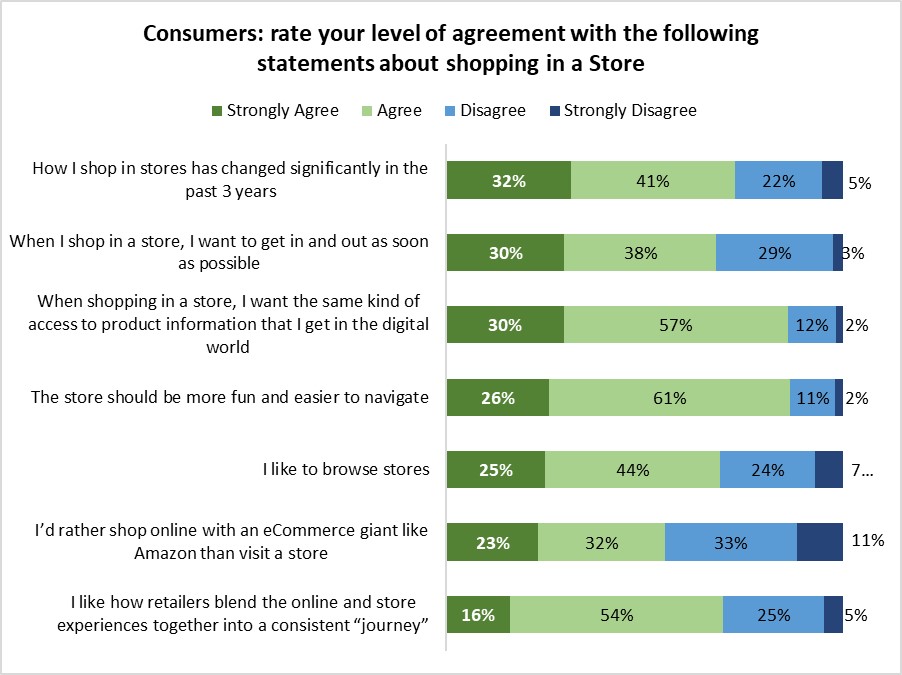Why The Retail Store Won’t Survive As A ‘Tech-Free Zone’
Back in 2003, American journalist Nicholas Carr wrote a piece for the Harvard Business Journal entitled “IT Doesn’t Matter”. It was a provocative title for sure, and it was embraced by CFOs in particular as “proof” that seemingly endless escalations of spending on IT needed to be reined in. In truth, what Carr was saying is something that we know to be true – that any strategic value created by IT is short lived, because it quickly gets copied by the competition and becomes commoditized (therefore, making IT spending more of a defensive measure than going on offense).
I could go on and on about this idea, but here’s the point of the story. I happened to be speaking at a conference in 2004 that featured Carr as keynote speaker. I asked him why he had titled his piece IT Doesn’t Matter, when in fact what he was saying was that most successful IT-driven innovations become part of the “infrastructure” of the business operating model very quickly. His answer was simple: “Well, it caused you to read the article, right?” I had to laugh – I had been lured in by an early example of clickbait.
It was in that spirit that the RSR team entitled its most recent benchmark on the state of the retail store “Why The Retail Store Won’t Survive As A ‘Tech-Free Zone’”. Of course there’s technology in the store! POS and back-office systems have been around for over 30 years. But the basic point we were trying to make was twofold: first, that for the majority of retailers, the only technology that anyone is likely to see is not for customers to use, but the store associates. Secondly, consumers use technology in virtually every part of their lives except when they are in the store.
Living as we do in this modern world, most of us want to have access to information that will save us some time, money, or free us from worry. The best example I can think of it Maps app on the Apple iPhone. The app can calculate the best route to a destination, and then based on current road conditions make suggestions for alternate routes. Another example that is becoming quite common is the QR code offered by restaurants to let diners look at the menu and make an order. The question is, why aren’t more ideas like that used to make the store shopping experience more efficient and enjoyable?
The answer to that is that many retailers are trying to get there – they just have a lot of catch up to do before they can reliably make the information available to consumers. For a lot of retailers, deferred on investment in foundational technologies now stands in the way of addressing new objectives.
An Outdated Foundation?

Source: RSR Research, April 2024
The tendency to defer on technology investments is especially true when it comes to FMCG retailers (supermarkets, C-store, drugstores). Given the razor-thin operating incomes that these retailers must work with, that is understandable, but it stands in the way of progress now. If there is any good news on this point, it is that retailers know what they’re up against and are moving towards modernization. For example, in a recent study that RSR conducted[1], we found that a surprising 56% (and 53% of FMCG’ers) of the retailers queried are planning new investments in the corporate WAN infrastructure to enable more network-centric business applications available to the stores.
That is great news, but (back to Nicholas Carr’s point) it has already been done by retailer leaders – so anyone else who is modernizing the store’s technology now is doing that as a defensive response, not to gain strategic advantage.
Why does any of this matter? Because, in an age when products can be bought almost anywhere at any time, consumers want the store experience to be more in tune with how they live their lives. Technology has permeated virtually every corner of modern living, and we all enjoy real-time access to information 24X7. But one of the few places where that is not the case is in the store, which when it comes to consumers seems like a tech-free zone. While shoppers may enjoy the familiarity of a visit to the store, they do not want to have their time wasted, they want access to product information while they are shopping and an experience that is in line with what they get when they sign on the ECommerce website. Proof? Here’s the data:
Consumers Like Stores, But…

Source: RSR Consumer Study, November 2023 (n=1132)
So, the message for retailers is that while consumers may still go to the store –retailers can’t take that for granted.
Consumer expectations are not the only driving force, of course. Store employees have many of the same expectations as consumers do – and they want their jobs to reflect how they live their lives. Most people would rather lose their wallet than their smart phone, and yet retailers force employees to use tools that were developed when we used fax machines.
The Bottom Line
Businesses can and should look for strategic advantages – and increasingly those advantages are enabled by information and technology. But there are two points to remember. First, any good idea will get copied and commoditized to the point where even single-door entrepreneurs can do what Walmart and Kroger can do. Secondly, businesses must have a technology foundation that enables innovation. “Innovation” is another subject for another day, but businesses cannot go around the foundational requirements – they have to make those investments to keep going.
Ergo, in this world the retail store as we know it won’t survive as a ‘tech-free zone’ much longer.
[1] The World Is Connected: The Store Must Be Too, RSR Benchmark, January 2024
